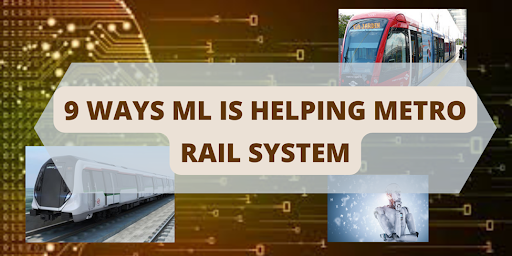Artificial intelligence (AI) and Machine Learning (ML) are having a significant impact on both our personal and professional life. Particularly in the transportation industry.
The global train industry has suffered from a lack of innovation for decades. And machine learning is assisting in the improvement and reinvigoration of the global train industry.
Machine learning is contributing to the development of the metro rail system. It helps ensure safer, greener, smarter, and more dependable modes of transportation.
Artificial intelligence and machine learning can help with traffic congestion as well as danger detection. It also helps with travel demand analysis and even greenhouse gas reduction.
When compared to other modes of transportation, metro rail transportation is once again being lauded. Of course, for its environmental friendliness, efficiency, and cost-competitiveness. Metro systems are heavy railways with exclusive rights-of-way that serve cities’ metropolitan zones.
But how can ML do the job of improving the metro rail system?
Ways Machine Learning Is Impacting the Metro Railway System
These machine learning systems also help with public safety, customer value delivery. It also helps with overall railway management and operations optimization.
Today’s superior AI and ML technology is a strong tool for unlocking the promise of future railway digitization. AI also has the potential to play a significant role in the advancement of metro rail.
- Predicting and Reducing Delays
After a machine learning model is trained, it needs to undergo ML model deployment and model monitoring.
Then the ML model is utilized in rail applications to improve train schedule, train speed control, and avoid accidents. ML also helps to predict delays, and improve asset management, among other things.
The extra time it takes a train to operate on a route owing to traffic problems is referred to as delay. Railroads frequently use the reduction in the delay to determine the benefit of a project or operational change.
Downstream conflicts with other trains, and variable stopping hours all cause delays. Train delays can be predicted with the use of Machine learning. This is done by first gathering all the related train data, and training an ML model with this model.
- Track Maintenance
Railways are an important part of the infrastructure of some of the world’s most developed economies, such as Europe, India, and Japan. AI and machine learning are bringing efficiencies to every sector of the economy. It’s no surprise that AI applications in railways have sparked a lot of research and interest.
Deep learning, a subfield under ML, has also been used for rail fault assessment and monitoring in Europe. It is also used in recent years by the scientific community. Deep learning, according to some academics, might be a component of the final completely automated train inspection system.
- Train Scheduling
Railway scheduling is the process of combining “demand” for rail transportation with “supply-side” restrictions. Its goal is to create timetables and resource plans that fulfill demand at a reasonable cost.
ML algorithms, simulation models, graphs, heuristics, and control systems can all be used to create train schedules. Supervised and unsupervised ML algorithms can be used to build an ML model. The ML model automatically schedules train appointments via a chatbot.
- Asset Management
Asset management encompasses all systems, processes, procedures, and tools used to reduce costs, improve performance, and reduce hazards throughout the life cycle of rail infrastructure.
For safe railway operations, the signaling system must function flawlessly. Railways rely entirely on the health of their signaling assets, as well as real-time data.
Smart sensors and cameras which have been trained with deep learning and ML are embedded in crucial rail components. This helps to take appropriate preventive actions in real-time.
- Controlling the Speed Profiles of Trains
Running times and comfort requirements are taken into account while creating train speed profiles. Hard signaling can be achieved with the help of an AI-based conflict resolution method (signal aspects). It also aids in train speed control. The speed profiles can then be calculated using Reinforcement Learning (RL) or dynamic programming.
- Predictive Maintenance
A well-maintained railway system is a necessary component of its successful operation. In this case, ML can be used for predictive maintenance. This allows operators to respond swiftly to current difficulties and predict possible failures on the rail track before they occur.
This eliminates the need for time-consuming root cause analysis. As a result, maintenance costs are lower, machine failure is lower, repairs are faster, and customer satisfaction is higher.
- Data Management
Many procedures are used in the rail sector. Such methods will generate a large amount of data that will only continue to grow in the future, making it harder to manage.
Data can be collected digitally using cloud-based AI and ML technologies. Then data analysis can be performed which helps to reduce price and maintain accessibility.
- Biometrics
Machine learning can be used to build biometrics applications for railways. Retina scans, voice verification, vein scans, facial recognition, and fingerprint scans are all examples of biometric ticketing.
If put into action, many train stations would see a significant reduction in overcrowding, as well as the elimination of ticket barriers and rush-hour lines.
- Automated Driving
A train driver is in charge of the train’s starting and stopping, as well as the operation of its doors and the handling of crises or unexpected detours. Although the train starts and stops automatically, a driver operates the doors, drives the train if necessary, and handles emergencies.
A key application of ML is self-driving vehicles. Greater capacity on the rail network is provided by ML through automated trams, metros, and trains.
Conclusion
AI systems have the potential to improve railway maintenance and safety. We can see that deep learning is quite good at detecting all forms of errors, which may be used to flag problems and do predictive maintenance. This could eventually save a lot of money in terms of both people and resources, but it will require significant investments.
As discussed in this article ML is helping the metro rail system in terms of train maintenance and scheduling. It also helps in predicting and reducing delays, asset management. And it helps with data management, automated driving, and so many other ways.
With all this information, it is safe to say that we would see more ML in metro rail systems in the future.


